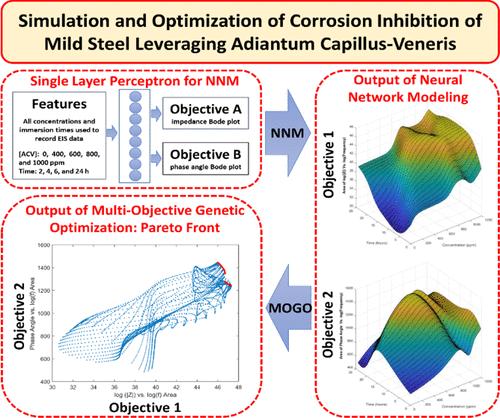Adiantum Capillus-Veneris Extract as a Sustainable Inhibitor to Mitigate Corrosion in Acid Solutions: Experimental, Machine-Learning Simulation, and Multiobjective Optimization
IF 3.9
2区 化学
Q2 CHEMISTRY, MULTIDISCIPLINARY
引用次数: 0
Abstract
Green corrosion inhibitors have been widely used as sustainable replacements for synthetic organic inhibitors. The application of adiantum capillus-veneris (ACV) extract to mitigate mild steel corrosion in a hydrochloric acid solution was the main focus of this investigation. Corrosion inhibition was studied using electrochemical impedance spectroscopy (EIS) and polarization techniques. EIS curves were modeled using a shallow neural network. Subsequently, a multiobjective genetic algorithm was employed to identify the optimal combination of concentration and time, represented by a Pareto front. EIS revealed an inhibitory efficacy of 88% at the optimal concentration of 800 ppm. Polarization results showed that ACV acted as a mixed inhibitor, and at 800 ppm, the corrosion current density decreased from 105 to 44 μA/cm2. Surface analytical techniques confirmed the corrosion-inhibitory effect of ACV. Results indicated that the sample selected from the lower lobe of the Pareto front, dominated by impedance magnitude, outperformed other tested samples. Furthermore, the machine learning-based corrosion prediction model demonstrated a high accuracy. This work highlighted the viability of machine learning in assessing corrosion resistance and improved the generalization capacity of optimizing corrosion inhibitors.

作为一种可持续缓蚀剂减轻酸溶液中的腐蚀:实验、机器学习模拟和多目标优化
绿色缓蚀剂作为合成有机缓蚀剂的可持续替代品已被广泛应用。本研究的主要目的是研究毛茛(ACV)提取物在盐酸溶液中对低碳钢的腐蚀。利用电化学阻抗谱(EIS)和极化技术对其缓蚀性能进行了研究。利用浅神经网络对EIS曲线进行建模。随后,采用多目标遗传算法确定浓度与时间的最优组合,以Pareto前沿表示。在最佳浓度为800 ppm时,EIS的抑菌效果为88%。极化结果表明,ACV作为混合缓蚀剂,在800 ppm时,腐蚀电流密度从105 μA/cm2下降到44 μA/cm2。表面分析技术证实了ACV的缓蚀作用。结果表明,以阻抗大小为主导的帕累托前下叶选择的样本优于其他测试样本。此外,基于机器学习的腐蚀预测模型具有较高的准确性。这项工作强调了机器学习在评估耐腐蚀性方面的可行性,并提高了优化缓蚀剂的泛化能力。
本文章由计算机程序翻译,如有差异,请以英文原文为准。
求助全文
约1分钟内获得全文
求助全文
来源期刊

Langmuir
化学-材料科学:综合
CiteScore
6.50
自引率
10.30%
发文量
1464
审稿时长
2.1 months
期刊介绍:
Langmuir is an interdisciplinary journal publishing articles in the following subject categories:
Colloids: surfactants and self-assembly, dispersions, emulsions, foams
Interfaces: adsorption, reactions, films, forces
Biological Interfaces: biocolloids, biomolecular and biomimetic materials
Materials: nano- and mesostructured materials, polymers, gels, liquid crystals
Electrochemistry: interfacial charge transfer, charge transport, electrocatalysis, electrokinetic phenomena, bioelectrochemistry
Devices and Applications: sensors, fluidics, patterning, catalysis, photonic crystals
However, when high-impact, original work is submitted that does not fit within the above categories, decisions to accept or decline such papers will be based on one criteria: What Would Irving Do?
Langmuir ranks #2 in citations out of 136 journals in the category of Physical Chemistry with 113,157 total citations. The journal received an Impact Factor of 4.384*.
This journal is also indexed in the categories of Materials Science (ranked #1) and Multidisciplinary Chemistry (ranked #5).
 求助内容:
求助内容: 应助结果提醒方式:
应助结果提醒方式:


